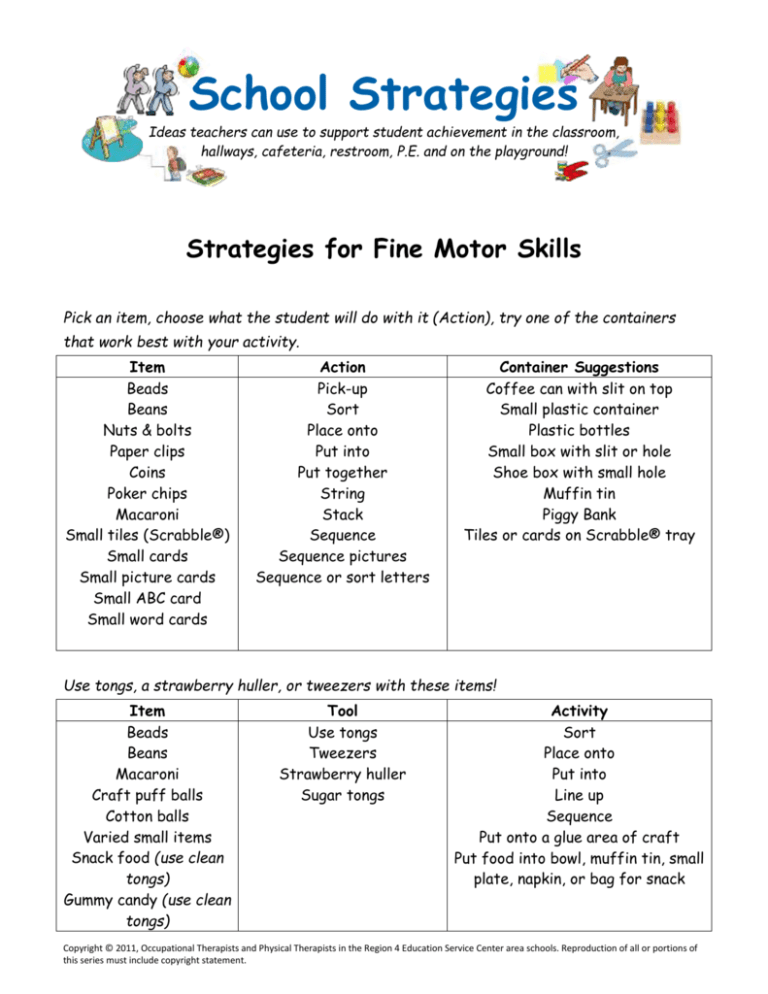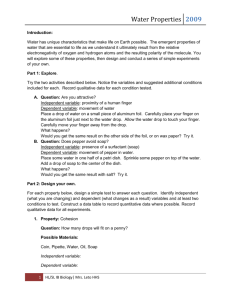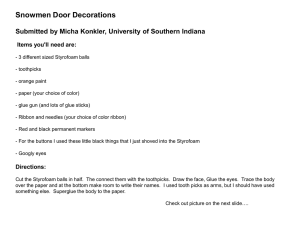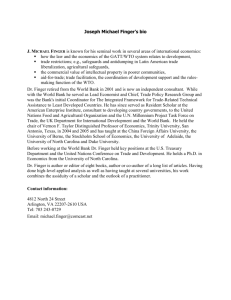Activities for Fine Motor
advertisement

School Strategies Ideas teachers can use to support student achievement in the classroom, hallways, cafeteria, restroom, P.E. and on the playground! Strategies for Fine Motor Skills Pick an item, choose what the student will do with it (Action), try one of the containers that work best with your activity. Item Beads Beans Nuts & bolts Paper clips Coins Poker chips Macaroni Small tiles (Scrabble®) Small cards Small picture cards Small ABC card Small word cards Action Pick-up Sort Place onto Put into Put together String Stack Sequence Sequence pictures Sequence or sort letters Container Suggestions Coffee can with slit on top Small plastic container Plastic bottles Small box with slit or hole Shoe box with small hole Muffin tin Piggy Bank Tiles or cards on Scrabble® tray Use tongs, a strawberry huller, or tweezers with these items! Item Beads Beans Macaroni Craft puff balls Cotton balls Varied small items Snack food (use clean tongs) Gummy candy (use clean tongs) Tool Use tongs Tweezers Strawberry huller Sugar tongs Activity Sort Place onto Put into Line up Sequence Put onto a glue area of craft Put food into bowl, muffin tin, small plate, napkin, or bag for snack Copyright © 2011, Occupational Therapists and Physical Therapists in the Region 4 Education Service Center area schools. Reproduction of all or portions of this series must include copyright statement. Every day materials that can help develop fine motor skills. Item Bubble wrap Newspaper, magazine pages, tissue paper, recycled paper Newspaper or magazine pages Zippered bags, mesh bags can often be found at the dollar store Hole punch, or craft punch Straws Egg shells, food coloring Table, paper, tape Large paper Chocolate chip cookies & toothpicks Rocks, gold paint, aluminum pie pans, and sand Aluminum foil, small food pieces or pretend nuts Action Pop bubbles by pinching or isolate a finger to pop by poking at the bubble Tear paper into strips or squares Crunch pieces of paper into balls Put students favorite items in the bag, this may motivate them to open/close bag often Use hole punched paper as animal “feed”, mosaics, or in crafts. String straws cut into pieces (nice cutting activity). Spray them with a mixture of bleach and water to kill any germs, then let dry. Crush the egg shells and add different colors of food coloring. When the shells are the color you desire, take them out of the food coloring and let dry. Have the children use the colored egg shells to create a beautiful collage! Have the kids draw shapes or pictures on the floor, under a table (tape paper to the bottom of the table). This promotes strengthening (proximal to distal) to prepare them for writing. Get sheets of paper (approximately 4 feet) and have the child sit on a “X” at the edge of the paper. Have the children draw their own rainbow. This is a good “crossing midline activity”. Give the children small chocolate chip cookies and toothpicks and have them try to pick out the chips with the toothpicks very gently, just like a paleontologist would when digging for bones. Paint a handful of rocks with gold paint and mix them with sand in the sensory table. Add enough water to cover the sand, resembling a stream bed. Give children aluminum pie plates and allow them to swish the water/sand mixture in a circular motion. The heavier "gold nuggets" will remain in the bottom of the pan. Feed the Squirrels (your students): Pre make some foil wrapped surprises for your "squirrels" to find and Copyright © 2011, Occupational Therapists and Physical Therapists in the Region 4 Education Service Center area schools. Reproduction of all or portions of this series must include copyright statement. Aluminum foil and cardboard Peanut butter, powdered milk, and honey, or Peanut butter, cocoa, and powdered sugar Whipped cream Mud eat - use real nuts or use marshmallows,other treat or pretend food - hide the foil wrapped treats around the room. Children pretend to be squirrels - and scamper around finding the treats, unwrapping the tin-foil like a squirrel getting the nut out of its shell. Make horse shoes: Cut several horse shoe shapes from sturdy cardboard. Allow children to trace around the shape on heavy paper and cut out. Have aluminum foil strips ready for them to wrap around their cut out (you may want to secure with a bit of glue on the edges); they can even play a game of horse shoes, indoors or out, with their project. Mix the three ingredients until slightly firm and not too sticky. Students can mix it in a sturdy Ziploc® bag. When ready, pinch off small pieces and roll into balls. This can be animal or pet “food”. Option: roll the balls in powdered sugar, shaking off excess. Finger paint on blue construction paper when dry it makes pretty clouds Finger paint with mud (with a little glue mixed in to keep from cracking when dry) These games and toys engage students in using their fine motor skills during play. Toy Lite-Brite® Wikki Sticks® Clay or Playdough® Lacing Cards Puzzles Operation® Games with small pieces Sand toys Water toys Bubble blower Sidewalk chalk Finger Paints Beads for stringing Fine Motor Skill Pushing lite-brite pieces into the grid and paper Bending, folding, manipulating the wikki stick Pinch, making rolls and balls, cut with plastic knife, or, hide small items in the dough for children to find Pinch string, and coordinated movement with card & string with two hands Hand/finger manipulation Using tweezers with small pieces Pinch, grasp, release Using hand strength and manipulation Manipulating with hands, squirt toys are extra beneficial Holding wand, dipping into bottle, popping bubbles with finger Pre-writing skill Finger manipulation Pinch used on beads and string, coordinated movement with bead and string with two hands Copyright © 2011, Occupational Therapists and Physical Therapists in the Region 4 Education Service Center area schools. Reproduction of all or portions of this series must include copyright statement.







